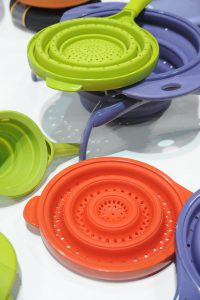Pauline Herbst speaks to IHA’s lifestyle trend forecaster Tom Mirabile, Senior Vice President of Global Trend & Design, Lifetime Brands, Inc., about top consumer trends for 2013-2014 and what manufacturers and retailers alike must do to stay relevant.
Mirabile says, “The big message is that sometimes we lose perspective on who the consumer really is and what is important to them. We have a picture in our heads of who they are, how they live and what drives their spending, and it’s often way off the mark. A lot of the time, in housewares in particular, we need a reality check. We need to look at ourselves as retailers and manufacturers and say, OK, where do we stand in relation to the customer today?”
 Consumer Trends
Consumer Trends
He identifies four key consumer trends for 2013: the need to engage both young and mature consumers; new evolutions of the American dream; the redefinition of value and luxury; and learning the difference between our perceptions of the consumer market and reality.
Young and Old
As Mirabile explains, there are two enormous groups driving sales that we need to understand, Gen Y, aged 17 to 36 and Baby Boomers, aged 47 to 67. Between them, they generate 62% of consumer spending. Mirabile says, “Gen Y is finally starting to move out on their own, they’re starting homes of their own, purchasing home and housewares products for the first time and so understanding what they want and how they view the world is essential, since it is so different from previous generations. They’re creative; they really are a maker, fixer, mover culture that find satisfaction and fulfillment in creating, doing things on their own rather than just engaging in ‘off the shelf’ goods and experiences. And they are big on bringing external experiences into the house – if they have a great dish or dessert at a restaurant they’re more likely to try to find a way to create that experience at home than other generations. Think cake pops, macaroons, gourmet cupcakes, etc.”
This generation also learns about trends from each other and creates its own trends rather than being driven solely by what retailers or brands tell them the trends are, which means retailers have to be more reactive. The good news is that once they’ve found a brand they like, Gen Ys tend to stay loyal and share it with their peers. This generation also loves to save, and are more likely to respond to online “daily deals” offers than any other age group.
The reality check is that almost 60 percent of Gen Ys get money from their parents and spend between two to four times their own incomes. But, you’re not selling to all 84 million Gen Ys. It’s the ‘Gen Y Affluent’ that need to be targeted; those living with their parents as well as those who are married with children and are aspiring heads of their own households.
 “We’re used to serving boomers, developing products to them, marketing to them, they rule the world. In our heads, we continue to treat them like the only important consumer group, and that’s an outdated view. We need to start engaging more with younger consumers,” says Mirabile.
“We’re used to serving boomers, developing products to them, marketing to them, they rule the world. In our heads, we continue to treat them like the only important consumer group, and that’s an outdated view. We need to start engaging more with younger consumers,” says Mirabile.
Today’s boomers are reinventing retirement as they are working longer. The new life stage for baby boomers is about stabilizing and staying put. They spend less on objects and more on experiences and on educating their adult children. They see themselves as evolving rather than aging, but unfortunately, they are not as healthy as planned, with the rate of diseases like obesity and high blood pressure higher than any other generation.
With baby boomers caring for four generations, including themselves, aging parents, adult children and grandchildren, retailers and manufacturers need to be relevant, keep products simple and user- friendly and educate their customers. Most importantly, Mirabile reminds us, products have to be “accessible to every generation, simple to use and easy to ‘adopt’. Today’s consumer is focused on three key attributes: products that save them time, those which save them space and of course products that save them money. Multi-function is also a key driver, buying one item that performs multiple tasks.” Cross-generational concerns include cooking, and health and wellness.
The New American Dream
Enter the new American Dream, described by Mirabile as incorporating five factors: a quest for happiness, personal independence, fulfilling one’s potential, owning a home and the freedom to go anywhere. A house with white picket fence still features, but it’s the kitchen that takes center stage, acting as a place for entertaining, family interaction and memory making. The kitchen area is projected to take the largest share of consumer dollars that will be spent on home renovation over the next two years.
“Design has become a crucial purchase consideration,” says Mirabile. “Whenever functional objects enter the social aspects of our lives, design becomes important. Housewares have earned their place as status symbols. Open-space kitchen and entertaining layouts mean that consumers and their friends and guests in the home are seeing household items all the time, and that means they have to have more decorative value… they are a visible expression of our personal style, just like clothing or automobiles. Ask yourself what status markers you are delivering – are you delivering a status of design? Of eco-consciousness? Charity? Design savvy? because those status markers are what people look for. Status isn’t just about wealth anymore, it’s more complex than that.”
He adds, “We’re the big ‘what’s next’ culture. Breakfast and brunch are the next big deals, along with mocktails, with lots of interest in non-alcoholic beverages. Tea is the new coffee while cured meats and charcuterie are also big on the list. Consumers crave the new. It represents innovation, advancement, excitement and status – new will always be perceived as better. You all buy products and sell products, but sometimes you don’t need a better product – you just need a new product.”
And ignore multiculturalism at your peril. Mirabile cautions that in the U.S., it’s important to recognize the important Hispanic market, slated to grow 20 percent over the next 10 years. While doing so, celebrate local U.S.-made product, which customers are open to, if the price is right.
Take-home messages from Mirabile include the customer’s desire to have anything, anytime and anyplace – so online offerings need to be up-to-date and offer price visibility and value, whereas brick and mortar should be “exploratory and offer an experience.”
Customers also want more time. With 46 percent of all adult eating occasions conducted alone, 48 percent of adult eating occurring between meals and a staggering 50 percent of meals eaten outside of the home, in the car or at desks, housewares need to make mobility easy.
Retailers are challenged to bring a fresh perspective to the marketplace, acting as curators and editors for time and choice-challenged consumers. “Trust is the gateway to increased market share, so leverage your point of view and expertise,” says Mirabile. “Consumers aren’t looking for just another place to shop, they’re looking for retailers which understand them as individuals…”
 Value and Luxury Redefined
Value and Luxury Redefined
In the current soft economy, the terms value and luxury have been redefined to reject throwaway culture with consumers preferring to repair goods, research their purchases and save to buy more durable products, which do more.
Smart, value driven shopping is now a badge of honor, not of shame as it was in the ‘90s. Also, while baby boomers determine “value” by evaluating price, quality and design, Generation Y expects the additional attributes of experience and compassion. Mirable says, “Younger generations expect more, they want products which can be personalized to their tastes, that deliver a lifestyle experience to them, and that support their own values of fair labor and fair trade. Do-It-Yourself (DIY) is also a new frontier. The shame is not value; it’s saying I can’t do it myself. Many consumers find that it’s enjoyable to save money by cooking, and actually satisfyingly creative, so home cooking is up remarkably.” Convenience is key, stimulating competition from all angles. With drug stores selling grocery and supermarkets selling more housewares, manufacturers need to look to new channels to serve a consumer that want to find what they want where they are, decreasing the number of stops they have to make.
So where does luxury fit into a DIY world? Mirabile explains that luxury is now intangible, represented by intuitive functions like those that control your washing machine with your phone; products that allow consumers to personalize their experience, like SodaStream; space- saving devices that nest or collapse; and unique, desirable and simple experiences and solutions.
The Wake-up Call
Mirabile ended his address with a wake-up call and call for action. Society has diversified in new ways. Children are optional, as is marriage, households are increasingly multigenerational, and the adults over 50 are experiencing accelerated divorce rates. He stated: “The ‘average family’ of 2 parents, 2.5 kids and a dog is an outdated (and diminishing) standard we need to forget. We live in a market of niches, and that means broadening our awareness and tailoring our offerings.”
Targeting traditional married couples with children only covers 20 percent of the market, so retailers need to expand their view to include the seven-plus types of families in today’s homes, including gay and lesbian couples with children and grandparents raising grandchildren.
Consumers are also using new tools like mobile apps and widgets to empower themselves and save time shopping. They discover products using social media services, when pop-ups let them know about discounts nearby, and through unsolicited suggestions from companies like Amazon. Pinterest has become important, with items pinned often resulting in later purchases.
These tools all represent new ways of educating and interesting the consumer in products and experiences he or she likes. As Mirabile says: “There are no rules – anything goes – just keep in mind who your target market is and deliver product that speaks authentically to their lifestyle. ”Perception needs to give way to reality. We’re eating four meals a day, not three, grilling all year, shopping at dawn if the fancy takes us, and making decisions on overall value, not just price… simplified views of the consumer and their needs/desires only weaken our position.
So shake up your perceptions and get ready to delight a new, social-media savvy consumer that will rock every expectation.



